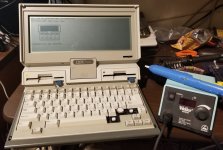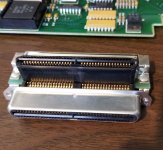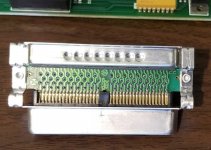Eudimorphodon
Veteran Member
It is interesting how that’s put together; it looks like it uses the same female connector that mates to the expansion bus externally as the “slot” for that board. I wish they’d used the female end on the system unit instead of the male, then we’d be on easy street. (Comparatively speaking.) Presumably that connector was available commercially at some point for that third party to have laid hands on it...
So I suppose if you have a spare system unit and a gut-able spare slice I could try taking a shot at it, I’ve been looking for another project? The available board area looks similar to the 100x100mm Tandy Plus Cards I’ve made and I was able to get a CF-Lite and a dual serial port combo into that space, although I’ll also need to factor in the address latches. (Fitting the original case plastics might be a challenge. If that’s not feasible could still make it work by salvaging the connector module only and looking at 3D printing a new shell?)
The original docs for the parallel/serial slices discuss the system having a simple “plug and play” system where the slice has a configuration register that is set by the system setup program to adjust the device address. I wonder if that’s necessary for a serial port to work or if hard decoding at the right address would be sufficient. It looks like that slice has any configuration register magic locked up in that ASIC, the discrete hardware on it doesn’t amount to much.
So I suppose if you have a spare system unit and a gut-able spare slice I could try taking a shot at it, I’ve been looking for another project? The available board area looks similar to the 100x100mm Tandy Plus Cards I’ve made and I was able to get a CF-Lite and a dual serial port combo into that space, although I’ll also need to factor in the address latches. (Fitting the original case plastics might be a challenge. If that’s not feasible could still make it work by salvaging the connector module only and looking at 3D printing a new shell?)
The original docs for the parallel/serial slices discuss the system having a simple “plug and play” system where the slice has a configuration register that is set by the system setup program to adjust the device address. I wonder if that’s necessary for a serial port to work or if hard decoding at the right address would be sufficient. It looks like that slice has any configuration register magic locked up in that ASIC, the discrete hardware on it doesn’t amount to much.





